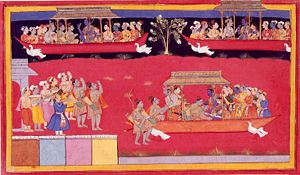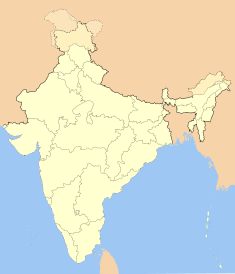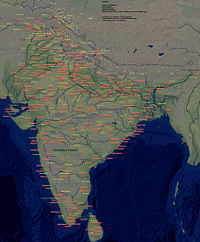Ayodhya
Ayodhya (Hindi: अयोध्या, Urdu: ایودھیا, IAST Ayodhyā), an ancient city of India, the old capital of Awadh, in the Faizabad district of Uttar Pradesh has been described as the birth place of Hindu god Shri Ram. Ayodhya, located at [1] has an average elevation of 93 metres (305 feet).
Legacy and Importance
This Hindu holy city, described as early as in the Hindu Epics, had been called Ayojjhā (Pali) during the time of Gautama Buddha. Under the British Raj the city and the administrative area around it went by the name Oudh. Situated on the right bank of the river Sarayu, Ayodhya lay 555 km east of New Delhi. In Sanskrit, ayodhya means "not to be warred against." Some Puranas like the Brahmanda Purana (4/40/91) consider Ayodhya as one of the six holiest cities in Hinduism.
In the first few centuries of the Common Era, Ayodhya had the name Śāketa. The great Kushan / Yuezhi Emperor Kanishka Śāketa, or 沙奇 (Pinyin: Shāqí), who made it the administrative center of his eastern territories, conquered the city in c. 127 C.E..[2] The name occurs again in Faxian as 沙祗 (Pinyin: Shāzhī) in the early fifth century. When the name changed remains unclear, but by the time of the visit of the Chinese pilgrim monk, Xuanzang, c. 636 C.E., the city had the name Ayodhya.
| Ayodhya Uttar Pradesh • India | |
| Coordinates: | |
| Time zone | IST (UTC+5:30) |
| Area • Elevation |
10.24 km² (4 sq mi) • 93 m (305 ft) |
| District(s) | Faizabad |
| Population • Density |
75,000 (2001) • 7,324 /km² (18,969 /sq mi) |
| Codes • Pincode • Telephone • Vehicle |
• 224123 • +05278 • UP-42 |
Coordinates: Ayodhya had been one of the most ancient, largest and most magnificent of Indian cities, covering an area of 250 km² (96 square miles). The city served as the capital of the Hindu kingdom of Kosala (Kaushal), the court of the great king Dasaratha, the 63rd monarch of the Solar line in descent from Vivaswan or the Sun God. The son of Vivaswan "Viavswat Manu" founded the city of Ayodhya. The opening chapters of the Ramayana, a mythological religious epic of the Classical Hindu period, recount the magnificence of the city, the glories of the monarch and the virtues, wealth and loyalty of his people. Dasaratha, the father of Rama, had been the Seventh Avatar of the Vishnu. Many Hindus believe that Ram Janmabhoomi, the site of the demolished Babri Mosque, had been the birthplace of Rama. According to the Ramayana, the House of Ikshvaku, the son of Manu, ruled Ayodhya. Eventually, Rama ruled Ayodhya.
Ayodhya also served as the birth place of five Tirthankars, including the first Tirthankar of Jainism, Shri Rishabh Dev, known as the father of Jain religion. The city displays evidence of its importance in the history and heritage of Buddhism in India, with several Buddhist temples, monuments and centers of learning having been established here during the age of the Mauryan Empire and the Gupta Dynasty. Ayodhya reached the peak of its golden age during the reign of the Guptas over India.
Bhagwan Swaminarayan, founder of the Swaminarayan Sect of Hinduism, lived here during his childhood years. Bhagwan Swaminarayan started his seven year journey across India as Neelkanth in Ayodhya. Tulsidas began to write his famous Ramayana poem Shri Ramacharitamanas in Ayodhya in 1574 C.E. Several Tamil Alwar mention the city of Ayodhya. Ayodhya had been the birthplace of Bhahubali, Brahmi, Sundari, King Dasaratha, Acharya Padaliptasurisvarji, King Harishchandra, Shri Rama, Achalbhrata, and the ninth Gandhara of Mahavir Swami.
The Atharva Veda called Ayodhya "a city built by gods and being as prosperous as paradise itself." Ayodhya had been the victim of pillage and sacking during the Ghaznavid raids and Ghorid invasions. Some Hindu temples had been looted and destroyed. Some believe that the Babri Mosque had been constructed on the remains of a temple, but that claim remains controversial. With Muslim rulers established around the city under Mohammed of Ghor, it lost its strategic and economic importance to Lucknow and Kanpur.
Ayodhya today exists as a small, rustic city with ancient Hindu architecture predominating, and with some Mughal influence. Its population, mostly Hindu, has a minority of Muslims, Jains and Buddhists. Its history and heritage hold an unequivocal importance for over Hindus in India and across the world. The Thai kingdom and city of Ayutthaya may have been named for Ayodhya, reflecting the common Southeast Asian practice of adopting place names from Hindu kingdoms.
According to an 11th century Korean chronicle the Samguk Yusa, the wife of King Suro of the ancient Korean kingdom of Geumgwan Gaya had been a princess who traveled by boat from a faraway land called Ayuta to Korea in 48 C.E. The common view has been that the Korean chronicles refer to Ayodha, but some scholars believe that the foreign land may have been Ayutthaya of Thailand. The Koreans know the princess as Heo Hwang-ok, the first queen of Geumgwan Gaya considered an ancestor by several Korean lineages.
Ayodhya Debate
| The Ayodhya debate |
|---|
| Timeline |
| Babri Mosque |
| Ram Janmabhoomi |
| Archaeology of Ayodhya |
| 2005 Ram Janmabhoomi attack in Ayodhya |
| People and organizations |
| L. K. Advani |
| All India Babri Masjid Action Committee |
| Babur |
| Bharatiya Janata Party |
| Koenraad Elst |
| Indian National Congress |
Ayodhya serves as the center of the Ayodhya Debate concerning the Ram Janmabhoomi temple and the Babri Mosque. Kar Sevaks and rioters destroyed the mosque in 1992 spurned by the belief that the Ram Janmabhoomi existed prior to the mosque's construction and that the temple had been the birthplace of Rama. The title suit on the disputed site awaits, pending, in the Lucknow Bench of Allahabad High Court.
Mob Attack
On 5 July 2005, five militants attacked the site of the makeshift Ramlalla temple, in Ayodhya. Security forces guarding the area shot all five in the ensuing gunfight, and one civilian died in the bomb blast triggered by the terrorists to breach the cordon wall. The claim of police that the militants came from Pakistan remains uncorroborated by independent evidence. The reason for the attack remains a mystery.
Gallery
See also
- Ramayana
- Bhagwan Swaminarayan
- Hou Hanshu
- Ram Janmabhoomi
- Babri Mosque
- Hanumangarhi
- Prakash vir Shastri
Notes
- ↑ Ayodhya Falling Rain Genomics, Inc. Retrieved June 18, 2008,
- ↑ Hill, John E. 2004. The Peoples of the West from the Weilüe 魏略 by Yu Huan 魚豢: A Third Century Chinese Account Composed between 239 and 265 C.E. Draft annotated English translation. Retrieved June 18, 2008.
ReferencesISBN links support NWE through referral fees
- Legge, James (1886): A Record of Buddhistic Kingdoms: Being an account by the Chinese Monk Fa-Hien of his travels in India and Ceylon (A.D. 399-414) in search of the Buddhist Books of Discipline. New York : Paragon Book Reprint Corp. : Dover, 1965. ISBN 9780486267609.
- Mandal, D., and Shereen Ratnagar. 2007. Ayodhya: archaeology after excavation. New Delhi: Tulika Books. ISBN 9788189487317.
- "India Begins Search for Contentious Ayodhya Temple". 2003. SCIENCE -NEW YORK THEN WASHINGTON-. (5615): 1958. OCLC 205067478.
- "India's Hindus After Ayodhya". 2002. ECONOMIST -LONDON- ECONOMIST-. 12. OCLC 194357968.
- Irani, Cushrow. 2004. Ayodhya, demolishing a dream. New Delhi: UBPSD. ISBN 9788174764751.
- Rawat, Vidya Bhushan. 2002. Sufi shrines of Ayodhya. Ghaziabad: Vidya Bhushan Rawat. OCLC 66644862.
- Thomas, F. W. (1944): “Sandanes, Nahapāna, Caṣṭana and Kaniṣka: Tung-li P’an-ch’i and Chinese Turkestan.” New Indian antiquary. 1938. Bombay: Karnatak Publishing House, p. 90.
- Watters, Thomas. 1973. On Yuan Chwang's travels in India, A.D. 629-645. New Delhi: Munshiram Mancharial. OCLC 221256602.
External links
- Sri Ramar Temple, Ayodhya divyadesamonline.com. Retrieved June 17, 2008.
- Ayodhya - Jainheritagecentres.com. Retrieved June 17, 2008.
- Entry on Ayojjhaa - Buddhist Dictionary of Pali Proper Names. Retrieved June 17, 2008.
- Pilgrim Centers Of India - bharatadesam.com. Retrieved June 17, 2008.
| Ramayana by Valmiki |
|---|
| Characters |
| Dasharatha | Kausalya | Sumitra | Kaikeyi | Janaka | Manthara | Rama | Bharata | Lakshmana | Shatrughna | Sita | Urmila | Mandavi | Shrutakirti | Vishvamitra | Ahalya | Jatayu | Sampati | Hanuman | Sugriva | Vali | Angada | Jambavantha | Vibhishana | Tataka | Surpanakha | Maricha | Subahu | Khara | Ravana | Kumbhakarna | Mandodari | Mayasura | Sumali | Indrajit | Prahasta | Akshayakumara | Atikaya | Lava | Kusha |
| Other |
| Ayodhya | Mithila | Lanka | Sarayu | Treta Yuga | Raghuvamsa | Lakshman Rekha | Aditya Hridayam | Oshadhiparvata | Sundara Kanda | Vedavati | Vanara |
| |||||||
Credits
New World Encyclopedia writers and editors rewrote and completed the Wikipedia article in accordance with New World Encyclopedia standards. This article abides by terms of the Creative Commons CC-by-sa 3.0 License (CC-by-sa), which may be used and disseminated with proper attribution. Credit is due under the terms of this license that can reference both the New World Encyclopedia contributors and the selfless volunteer contributors of the Wikimedia Foundation. To cite this article click here for a list of acceptable citing formats.The history of earlier contributions by wikipedians is accessible to researchers here:
The history of this article since it was imported to New World Encyclopedia:
Note: Some restrictions may apply to use of individual images which are separately licensed.





